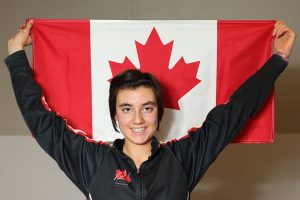Legacy babies of Calgary Olympics keep Canada’s ski jumping program alive

Dan Barns Financial Post Feb 6, 2018
Mackenzie Boyd-Clowes and Taylor Henrich are the entire team for Pyeonchang but behind them is a new wave of even fresher faces. It’s a modest program now, but there is a future
Veterans of 1988 know it as Paskapoo, that busy place on the hill to the west, where the ski jumps stretch like grain elevators against the sunset, casting shadows of days gone by over the city of Calgary.
It’s called Canada Olympic Park now, and both Mackenzie Boyd-Clowes and Taylor Henrich grew into the athletes they are in those shadows and on those jumps, which were built for the 1988 Winter Olympics.
Boyd-Clowes, 26, and Henrich, 22, are legacy babies who will represent their city and their country in Pyeongchang next month.
They are Canada’s Olympic ski jumping team. It’s too small, for certain, as Ski Jumping Canada CEO Tom Reid and head coach Gregor Linsig were hoping for at least twice that many athletes, especially since there were six in Sochi, where women’s ski jumping made its Olympic debut.
Atsuko Tanaka and Henrich finished 12th and 13th respectively. Boyd-Clowes was 25th on the large hill, the only Canadian man to make a final on a team that included Dusty Korek, Trevor Morrice and Matthew Rowley.
It surely feels like this program has taken a step backward. But Boyd-Clowes and Henrich are keeping the flame lit, the legacy of 1988 alive.
“My mom started me in a program here at COP through a summer camp,” Henrich said in a December interview. “I really liked jumping off stuff and what kid doesn’t, right? I’m definitely an adrenalin junkie. I love extreme sports, they’re in my blood. Anything related to extreme has my name written all over it and ski jumping was one sport that just stood out. You get to fly. It’s a lot of fun.”
Boyd-Clowes, who was born in Toronto, said he didn’t even know what ski jumping was, but his parents put him in a summer camp at COP and he found out soon enough.
“I didn’t have dreams of becoming a ski jumper right then. It grew over time. My story of becoming a ski jumper is vastly different than a lot of the guys who are really, really successful in the bigger countries because they were able to watch it on TV and have these idols. I never had people to look up to, examples of what the sport really was. But I’m glad I did it.”
Boyd-Clowes has since attached himself to the U.S. team and spends eight months a year in Europe. He trains mostly in Slovenia, where ski jumping is king, and the best athletes get their faces on billboards and their wallets stuffed with sponsorship cash.
“Slovenians are the top four or five teams in the world. There are huge superstars coming out of the ski jumping program. So they’ve got new facilities, lots of money and lots of interest in ski jumping,” said Boyd-Clowes.
“It’s a 20-minute drive from where I live to the gym and on that drive you’ll see six or seven billboards with ski jumper’s faces on them. Which is a little bit different than here.”
The ski jumping team doesn’t have a profile in Canada. But Boyd-Clowes is hitting the incredibly competitive World Cup top 30 and 40 and Henrich won a world championship medal a few years ago. Behind each of them is a new wave of even fresher faces. It’s a modest program now, but there is a future.
“I’m seen as an underdog on the European scene,” said Boyd-Clowes. “They don’t have high expectations of me, coming from Canada, because they know it’s not a big sport here. I can often times surprise them with good results.”
If the Canadians get those results in Pyeongchang, they will raise eyebrows and they might just attract more kids to the jumps in Calgary. Boyd-Clowes said he was comfortable on the wind-swept hills in Pyeongchang at a test event last year, since the blustery conditions reminded him of home.
“I immediately clicked with the hills. It made sense to me. There were changing winds which sometimes affects the other jumpers more than me, because I’m used to jumping (in Calgary). On the small hill in Pyeongchang last year, I was top seven in the world all rounds but one. I ended up dropping a few places in the last round. In qualifications I think I was sixth. After the first round I was seventh. That was a pretty huge confidence boost.”
Henrich is aiming for top 10 in Pyeongchang but has had an off year, one complicated by an ankle injury. She is still the leader of the pack in Canada, but the pack — Natasha Bodnarchuk, Natalie Eilers, Nicole Maurer and Abigail Strate — is charging. And they’re all Calgary-born legacy babies, just like Henrich.
“I was in a summer camp that took me through a bunch of different sports. One was ski jumping,” Bodnarchuk said. “I guess I was one of the kids who actually wanted to try it. There was a coach nearby who was recruiting people. He came up to me and saw that I was doing it, I was landing. He said ‘Natasha, you’re a future Olympian.’ So I just fell in love with it.”
She is the future. After falling just short of qualifying for Pyeongchang, she will be looked upon to lead the women’s team into 2022 in Beijing. To keep the flame lit, the legacy alive.
• Email: dbarnes@postmedia.com |





